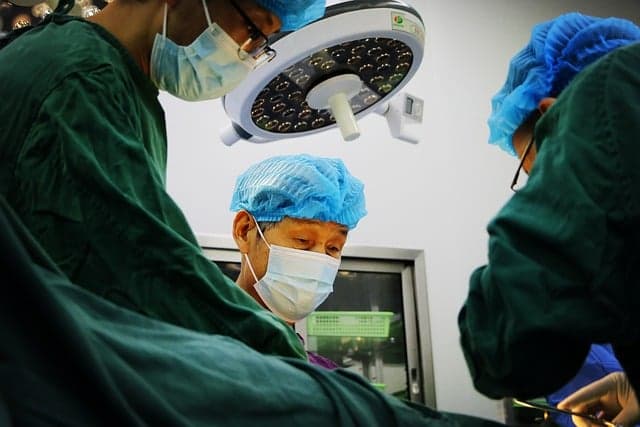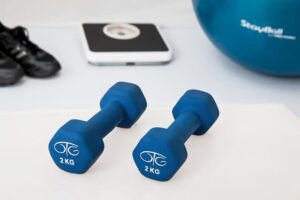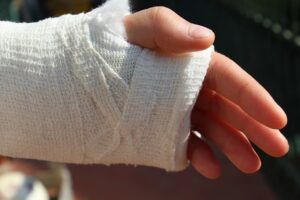Shoulder endoprosthetics can cure severe shoulder joint diseases even in the most severe cases, when no other methods help to get rid of chronic pain and restore mobility of the arm. But it is a complex, traumatic operation, after which you need to recover for a long time. It will take more than one week before the soft tissues fuse, and several more months will be needed for the endoprosthesis to grow into the bone. During this time, it is important to prevent the development of contractures, to achieve good mobility and stability of the joint, to restore coordination of movements, and then – the strength and volume of muscles. All of these goals can be achieved during rehabilitation.
Stages
Rehabilitation after shoulder endoprosthetics takes place in three stages (phases). The first is up to 6 weeks, the second is up to 12 weeks, and the third is up to 6 months after surgery. Some authors divide the first phase into two more: the first one lasts up to 2 weeks. This is the period of healing of postoperative wounds.
Rehabilitation begins the day after the operation, but the main rehabilitation activities are carried out from 6 months – after completion and immobilization, when the person will no longer feel pain and will be able to develop the arm to increase the range of motion. The main method of rehabilitation in all periods is therapeutic exercise. In addition, medication support, physiotherapy, kinesiotherapy and other techniques are used. Loads are selected individually. They should be sufficient to ensure continuous progress, but at the same time not excessive, so as not to harm the operated joint, especially during the period when it is still not stable enough.
First phase
The first phase takes place against a background of inflammation. Only minimal loads on the operated joint are allowed. The patient is trained to wear a bandage or abduction cushion so that the position of the hand is optimal for normal fusion of the damaged tissues. An abduction position of 40-60 degrees is considered optimal.
The task of the first phase is to prevent complications, create favorable conditions for healing of soft tissues and the beginning of osseointegration (ingrowth of the endoprosthesis into the bone), as well as to reduce postoperative discomfort. The period of active inflammation lasts up to 10 days. To reduce pain and prevent complications, a person receives drug therapy. Physiotherapy and massage are often used.
In the first phase of rehabilitation, only movements in the pain-free range are allowed. There should not be a strong tension in the muscles. The arm can be bent to 90 degrees, withdrawn to a maximum of 60 degrees, rotated inward to 45 degrees. Outward rotation of the shoulder is not recommended at all or allowed up to 20 degrees.
But in the course of rehabilitation after shoulder endoprosthesis it is possible to perform exercises:
- with movements in other joints of the upper limb, except the shoulder joint;
- isometric – muscle tension without movements in the joints.
The patient can squeeze a rubber ball, rotate the hand and perform other exercises that improve blood supply to the muscles, make them tense and prevent atrophy, as well as reduce the risk of contracture formation.
Once the constant shoulder pain becomes recurrent, rehabilitation enters phase two. This means the elimination of postoperative tissue inflammation. During the same period, the difference in skin temperature in the area of the shoulder joint and near it disappears.
Second phase
In the second phase, there is no inflammation and the soft tissue has fully recovered, but the prosthesis is not yet integrated with the bone tissue. The bone tissue around the cementless endoprosthesis begins to grow and thicken.
In the period of 6-12 weeks after surgery, the main focus of rehabilitation is to improve shoulder mobility and coordination of movements. Strength training is not yet used during this period. Exercise should be pain-free.
By the beginning of the second phase, the splint is removed. The person begins to perform more active movements in the shoulder, first with the help of the healthy arm, and then without support.
The task of the second phase is to bring the mobility of the shoulder to the following values:
- flexion to 140 degrees;
- 90 degrees of extension;
- inward rotation to 70 degrees;
- outward rotation to 60 degrees.
These indicators are not always possible to achieve. You should strive for them, but not at any cost. If there is pain during movement, further mobilization is not carried out, as the risk of premature wear of the endoprosthesis increases.
In the second phase, exercises for rehabilitation after shoulder arthroplasty are aimed at improving the accuracy of movements. The skills required by the patient in everyday life are practiced, such as lifting objects, dressing, undressing, etc.
Methods of rehabilitation after shoulder endoprosthetics during this period:
- physical therapy;
- massage;
- physiotherapy;
- kinesiotherapy;
- mechanotherapy.
While the first stage is partly inpatient, the second stage is usually outpatient. The person periodically visits the medical center to undergo procedures and exercises.
Third phase
After 12 weeks comes phase 3 of rehabilitation, when the artificial joint is already integrated with the bone, movements in the joint are completely painless for the patient.
In the third phase, coordination training continues and strength training begins. Shoulder mobility is maximized. Doctors will work on increasing the volume and strength of the muscles of the upper limb and shoulder girdle. The duration of this period is 3 months (it ends 6 months after surgery).
Recommendations after recovery
While the rehabilitation after shoulder endoprosthesis is underway, as well as in the long term after surgery, there are still some limitations. Here are some tips to help you maintain good endoprosthetic results:
You should not do any throwing, waving, or jerking until 6 months after surgery (while the thickening process of the newly formed bone tissue continues).
Not only during the rehabilitation period, but also after its completion, you should constantly work on maintaining strong muscles of the arm and shoulder girdle, so exercises never stop. Supportive exercise will help to reduce the load on the artificial joint by strengthening the muscles, which will affect the service life of the endoprosthesis. The more often you exercise, the lower the risk that you will need another operation to replace the components of the artificial joint during your lifetime.


